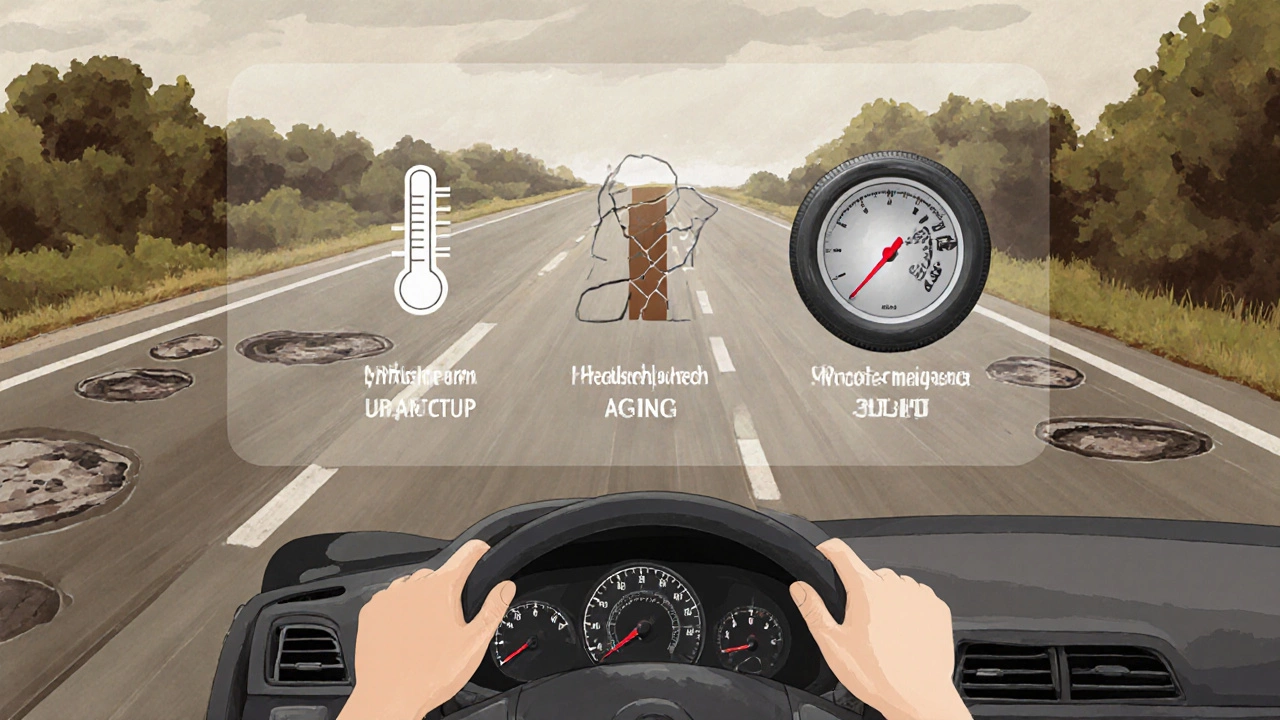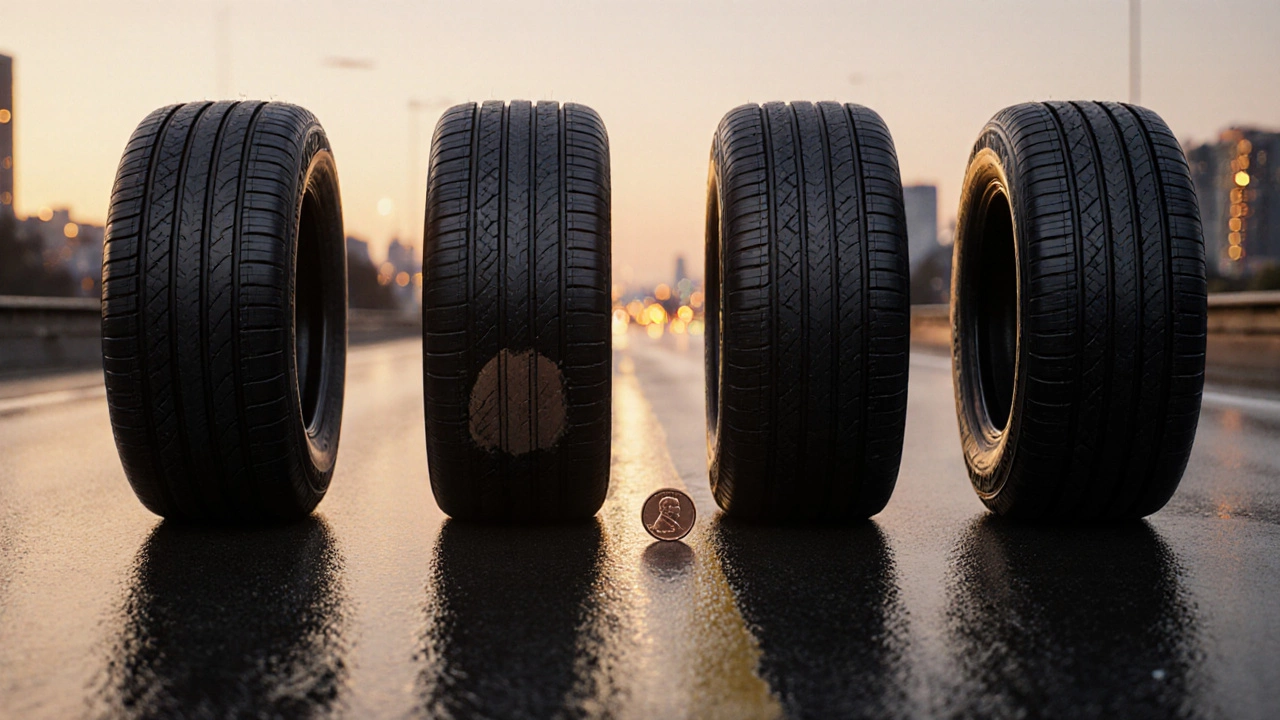Most drivers assume their tires will last around 50,000 miles. But that’s not always true. Some tires wear out in 25,000 miles. Others can hit 80,000 miles or more. So how long should 4 tires last? It’s not a fixed number. It depends on what kind of tires you have, how you drive, where you live, and how well you maintain them.
What Determines Tire Lifespan?
Tires aren’t like light bulbs with a set expiration date. They wear down based on real-world conditions. The biggest factors are tread depth, driving habits, road surfaces, and maintenance.
Most new tires start with 10/32nds of an inch of tread. When they hit 2/32nds, they’re legally worn out in most U.S. states. But safety experts recommend replacing them at 4/32nds - especially if you drive in rain or snow. At that point, stopping distance increases by 30% on wet roads, according to the Rubber Manufacturers Association.
Driving style matters a lot. If you’re constantly speeding, braking hard, or taking corners fast, your tires wear faster. Aggressive driving can cut tire life in half. On the flip side, smooth acceleration and gentle braking help tires last longer.
Road conditions play a big role too. Driving on gravel, unpaved roads, or roads with potholes wears tires quicker. Salt and chemicals used in winter roads can also degrade rubber over time. If you live in a city with rough pavement, expect to replace tires sooner than someone who drives mostly on smooth highways.
Typical Tire Mileage by Type
Not all tires are built the same. The type you buy sets the baseline for how long they’ll last.
- Standard all-season tires: These are the most common. Most last between 40,000 and 60,000 miles. Brands like Michelin, Goodyear, and Bridgestone often hit the higher end if properly maintained.
- Performance tires: Made for grip and handling, not longevity. These usually last 20,000 to 40,000 miles. The softer rubber that gives better cornering also wears out faster.
- Winter tires: Designed for cold weather and snow. They’re made from a different rubber compound that hardens in warm weather. Don’t use them year-round. They typically last 30,000 to 40,000 miles, but only if swapped out in spring.
- Ultra-high-performance and track tires: These are for enthusiasts. They can wear out in under 15,000 miles. Some last only 5,000 miles if driven hard.
- Truck and SUV tires: Heavier vehicles put more stress on tires. Expect 40,000 to 55,000 miles for most models, but heavy towing or off-roading can drop that to 25,000 miles.
How Maintenance Extends Tire Life
Even the best tires won’t last if you ignore basic care. Two things make the biggest difference: tire pressure and alignment.
Underinflated tires are the #1 cause of premature wear. When tires are low on air, the edges wear faster. Overinflated tires wear out in the center. Both reduce traction and fuel efficiency. Check pressure every month - and always when the tires are cold. Most cars list the correct PSI on a sticker inside the driver’s door.
Wheel alignment ensures your tires roll straight. If your car pulls to one side or the steering wheel is crooked when driving straight, your alignment is off. Misaligned tires can wear out in as little as 5,000 miles. Get an alignment checked every 10,000 miles or after hitting a major pothole.
Tire rotation helps too. Rotating tires every 5,000 to 7,500 miles spreads wear evenly. Front tires on front-wheel-drive cars wear faster because they handle steering and power. Rear tires on rear-wheel-drive cars wear slower. Rotating them balances the load.

Signs Your Tires Need Replacing
You don’t need a magic number to know when it’s time. Look for these signs:
- Tread depth below 4/32nds: Use the penny test. Insert a penny into the tread with Lincoln’s head upside down. If you can see the top of his head, it’s time to replace.
- Cracks or bulges: Dry rot from sun exposure or age can cause cracks on the sidewall. Bulges mean internal damage. Neither is safe to drive on.
- Vibrations or noise: If you feel shaking in the steering wheel or hear a rhythmic thumping, it could be uneven wear or a damaged tire.
- Age over 6 years: Even if tread looks good, rubber degrades over time. Most manufacturers recommend replacing tires after 6 to 10 years, regardless of mileage. Check the DOT code on the sidewall - the last four digits tell you the week and year it was made.
Real-World Examples
Here’s what real drivers experience:
One driver in Minnesota replaced their all-season tires after 48,000 miles. They rotated them every 6,000 miles, kept pressure at 35 PSI, and swapped to winter tires in November. The tread was still at 3/32nds - close to the limit.
A delivery driver in Phoenix hit 62,000 miles on the same set. They drove mostly on smooth highways, kept pressure high, and avoided sudden stops. The tires were still usable, but the rubber was starting to harden from heat and UV exposure.
Another driver in Chicago bought performance tires for their sports sedan. After 28,000 miles and a few aggressive track days, the tread was down to 2/32nds. They replaced them - but kept the old ones as spares for emergencies.
When to Replace All Four Tires
You don’t always need to replace all four at once. But you should.
If two tires are worn out and two are still good, putting new tires on the front can cause oversteer in wet conditions. The rear tires might lose grip first, making the car spin. Most carmakers recommend replacing all four together.
If you only replace two, put the new ones on the rear. This improves stability and reduces the risk of hydroplaning. Never put new tires on the front and keep worn ones on the back.
Some all-wheel-drive vehicles require all four tires to be nearly identical in tread depth. Even a 2/32nds difference can damage the drivetrain. Check your owner’s manual.
What About Tire Warranties?
Many tire brands offer mileage warranties. A 60,000-mile warranty doesn’t mean you’ll get 60,000 miles - it means the manufacturer guarantees you’ll get at least that much under normal conditions.
If your tires wear out early, you might get a prorated refund. For example, if you drove 30,000 miles on a 60,000-mile tire, you’d get 50% of the cost back. But you need to prove you maintained them properly - receipts for rotations, alignment checks, and pressure logs.
Warranties don’t cover damage from road hazards, curb impacts, or neglect. If you drive on underinflated tires and they blow out, you’re out of luck.
Final Answer: How Long Should 4 Tires Last?
For most drivers with average driving habits and regular maintenance, 4 tires should last between 40,000 and 60,000 miles. That’s about 3 to 5 years, depending on how much you drive.
But if you drive aggressively, live in rough conditions, or skip maintenance, you might need new tires in 25,000 miles. If you drive gently, check pressure monthly, rotate regularly, and avoid extreme weather, you could stretch them to 70,000 miles or more.
The key isn’t mileage alone. It’s checking tread depth, watching for damage, and listening to your car. Tires are the only part of your vehicle touching the road. Don’t wait until they’re bald to think about them.
How many years do tires last if not driven much?
Even if you drive very little, tires degrade over time due to heat, sunlight, and ozone. Most manufacturers recommend replacing tires after 6 to 10 years, no matter the tread depth. Check the DOT code on the sidewall to find the manufacturing date. If your tires are older than 6 years, have them inspected by a professional.
Can I drive on tires with 3/32nds tread?
Technically, yes - 3/32nds is still above the legal limit of 2/32nds in most places. But safety drops sharply at this level, especially in rain. Stopping distance increases by 30% on wet roads. If you live in a rainy or snowy area, replace them now. For dry climates, monitor closely and plan to replace within the next 1,000 to 2,000 miles.
Do expensive tires last longer than cheap ones?
Not always. A $150 tire and a $250 tire might both be rated for 60,000 miles. But higher-priced tires often use better rubber compounds that last longer and handle better. They also tend to have better warranties and more consistent wear. The real difference is in ride comfort, noise, and wet-weather performance - not just mileage.
Should I replace all four tires at once?
Yes, if you can afford it. Replacing all four ensures even grip, better handling, and safer braking. If you must replace only two, put the new ones on the rear axle. This prevents hydroplaning and loss of control in wet conditions. For all-wheel-drive vehicles, mismatched tread depth can damage the drivetrain - always replace all four.
Can I extend tire life by rotating them more often?
Rotating every 5,000 miles is ideal. Rotating more often - like every 3,000 miles - won’t hurt, but it won’t add much extra life either. The key is consistency. Skipping rotations for 10,000 miles or more causes uneven wear that can’t be fixed. Stick to the 5,000- to 7,500-mile window for best results.

